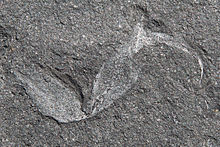Gondwanascorpio
| Gondwanascorpio | ||||||||||
|---|---|---|---|---|---|---|---|---|---|---|

Chela of Gondwanascorpio |
||||||||||
| Temporal occurrence | ||||||||||
| Upper Devonian | ||||||||||
| approx. 372 to approx. 359 million years | ||||||||||
| Locations | ||||||||||
|
||||||||||
| Systematics | ||||||||||
|
||||||||||
| Scientific name | ||||||||||
| Gondwanascorpio | ||||||||||
| Gess , 2013 | ||||||||||
| Art | ||||||||||
|
||||||||||
Gondwanascorpio is an extinct genus of scorpions with Gondwanascorpio emzantsiensis as the only known species . So far it has only been documented by individual fragments from South Africa; its age has been dated to about 372.2 to 358.9 million years. It is the oldest known species of scorpion on the continent of Gondwana and at the same time the oldest known terrestrial animal on the continent.
features

The description of Gondwanascorpio emzantsiensis as an independent species was based on a few fossil fragments. It was an almost complete chela with an attached patella of the pedipalp and a slightly damaged telson with an attached metasomal segment V, which correspond to those of the extinct Mesoscorpionina . The existing prints show some features that clearly distinguish Gondwanascorpio from other known scorpions and that justify the description as a new species within an equally new genus. Size estimates were not published due to the limited amount of material available.
The length of the “base” (manus) of the scissors corresponds to the patella, the scissors themselves with the fixed and movable limb (rami, singular: ramus) are elongated and about twice as long as the manus. According to the first description, the entire chela was about 22 millimeters long. These characteristics correspond to those of the Mesoscorpionina, but an assignment to this group was not carried out due to the few known characteristics. The gripping surfaces of the scissors are toothed, the teeth on the two rami alternating and each consisting of six teeth. The shape of the scissors largely corresponds to that of Pulmonoscorpius , but differs from it in the teeth; Comparisons with fossil finds of the genera Hubeiscorpio and Petaloscorpio, which are also known from the Devonian, are not possible due to the missing or only incompletely fossilized Pedipalps. The telson of the Gondwanascorpio was about 12 millimeters long including the sting. It corresponds to that of the Pulmonoscorpius , whereby a closer relationship may possibly be possible.
Location and chronological order
The fragments used to first describe the species and genus were found on the site of the Waterloo Farm locality near the South African city of Grahamstown in the municipality of Makana , Eastern Cape Province . The strata exposed here belong to the Witpoort Formation , which dates to the outgoing family in the late Upper Devonian (about 372.2 to 358.9 million years ago); the site is therefore likely to be around 360 million years old. The deposits consist of black, charcoal-like slate, which has formed through the anaerobic degradation of a layer of mud in the alluvial area of a marine estuary . The fossil finds from this deposit include algae and terrestrial plants, various fish, mussels, crabs , mussel shells and a sea scorpion (Eurypterida; a fossil group of animals that is not closely related to the scorpion).
Besides Gondwanascorpio emzantsiensis , there are very few fossil records of scorpions from the late Devonian. It is the oldest known evidence of a scorpion on the continent of Gondwana and at the same time the oldest known terrestrial animal on the continent. The only other potential land animal on Gondwana from late Devonian was Maldybulakia from Australia in 1998 , which may have been a terrestrial Myriapod ; however, today it is more likely that an aquatic representative of the swordtails (Xiphosura) is found. The next youngest fossils in South Africa come from insects that are dated to the early Permian about 90 million years later.
Taxonomy
Gondwana Scorpio emzantsiensis was in 2013 by Robert W. Gess in the scientific journal African Invertebrates first described . A taxonomic assignment within the scorpions was not carried out because this was not possible due to the existing characteristics; Gess classified the species accordingly within the scorpions as incertae sedis .
Naming
The scientific name of the genus Gondwanascorpio is based on a combination of the name Gondwana for the geological continent on which the scorpion lived and the Latin name of the scorpions ( scorpio ). The species name G. emzantsiensis is derived from the word umZantsi , which is taken from the South African language isiXhosa and translated as "south". It is occasionally used as a name for the state of South Africa.
literature
- Robert W. Gess: The Earliest Record of Terrestrial Animals in Gondwana: A Scorpion from the Famennian (Late Devonian) Witpoort Formation of South Africa. African Invertebrates 54 (2), 2013; Pp. 373-379. doi : 10.5733 / afin.054.0206
Web links
- Oldest land-living animal from Gondwana found . Science Daily, September 3, 2013.
- Bonnie Malkin: 'Oldest' Gondwana land creature discovered . The Telegraph, September 3, 2013.
- Kristen van Schie: Frozen in time: roadworks yield fossil find . Independent Online scitech, September 3, 2013.
